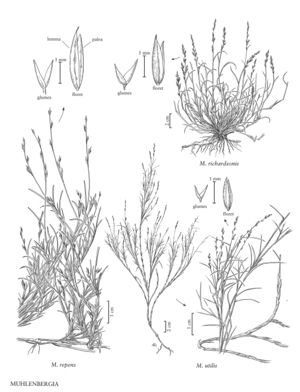Muhlenbergia repens
Plants perennial; rhizomatous, not cespitose. Culms 5-42 cm tall, 0.5-1 mm thick, decumbent near the base, forming dense mats; internodes glabrous, slightly nodulose. Sheaths shorter or longer than the internodes, glabrous; ligules 0.1-1 (1.8) mm, membranous, truncate, occasionally lacerate; blades 0.4-6 cm long, 0.5-1.4 mm wide, involute, glabrous, smooth or scabridulous adaxially. Panicles 1-9 cm long, 0.1-0.6 cm wide, contracted, not dense, usually partially included in the upper leaf-sheaths; primary branches 0.2-3 cm, usually closely appressed at maturity, rarely diverging up to 40° from the rachises; pedicels 0.2-3.6 mm, setulose. Spikelets 2.6-4.2 mm, occasionally with 2 florets. Glumes subequal, 1.1-3.6 mm, from 1/2 as long as to equaling the lemmas, light green, 1 (2-3) -veined, acute, unawned; lemmas 2.6-3.2 (4.2) mm, lanceolate, dark greenish or mottled, glabrous or the calluses and margins appressed-pubescent, hairs to 0.3 mm, apices scabridulous, attenuate, usually mucronate, mucros 0.1-0.3 mm; paleas 2.1-3.3 mm, lanceolate, smooth or scabridulous, acute; anthers 0.7-1.4 mm, yellow to purplish. Caryopses 1.1-1.5 mm, ellipsoid to ovoid, brownish. 2n = 60, 70-72.
Distribution
Utah, Ariz., Colo., N.Mex., Tex.
Discussion
Muhlenbergia repens grows in open, sandy meadows, canyon bottoms, calcareous rocky flats, gypsum flats, and on rolling slopes and roadsides, at elevations of 100-3120 m. Its range extends from the southwestern United States to southern Mexico.
Selected References
None.
Lower Taxa
"decumbent" is not a number.
